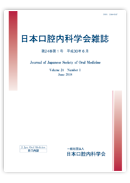Golimumab (GLM), a tumor necrosis factor (TNF) inhibitor, is approved as a rheumatoid arthritis (RA) drug and shows excellent effects. On the other hand, patients treated with GLM are susceptible to infection due to immunosuppression. We report a case of mandibular osteomyelitis developed in a patient with RA during the administration of GLM.
A 75-year-old woman with RA who had been treated with GLM for nearly four years consulted our department in March of 2017 with chief complaints of swelling and pain in the left mandible. She had undergone surgical extraction of the left lower 7th due to periodontal disease at a private dental office in November 2016. We made a diagnosis of mandibular osteomyelitis from clinical findings and CT scan results. Her condition was thought to be caused by a dental infection which rose from immunosuppression. In addition to the administration of antibiotics, the GLM treatment was suspended temporarily by the orthopedic doctor, and acute symptoms disappeared. Out of necessity, the GLM treatment was restarted to control RA one month later, and we decided to continue to observe her condition. Although chronic symptoms such as fistulas are still present, she is rejecting the surgery because of the absence of pain or swelling, and it is impossible to interrupt the GLM treatment for an extended period. Therefore, we are hesitant to start the surgery considering her quality of life, and we are continuing to observe her condition with the administration of antibiotics.
When administering biological disease-modifying antirheumatic drugs such as TNF inhibitors, both oral management and medical-dental collaborations are very important.
View full abstract
